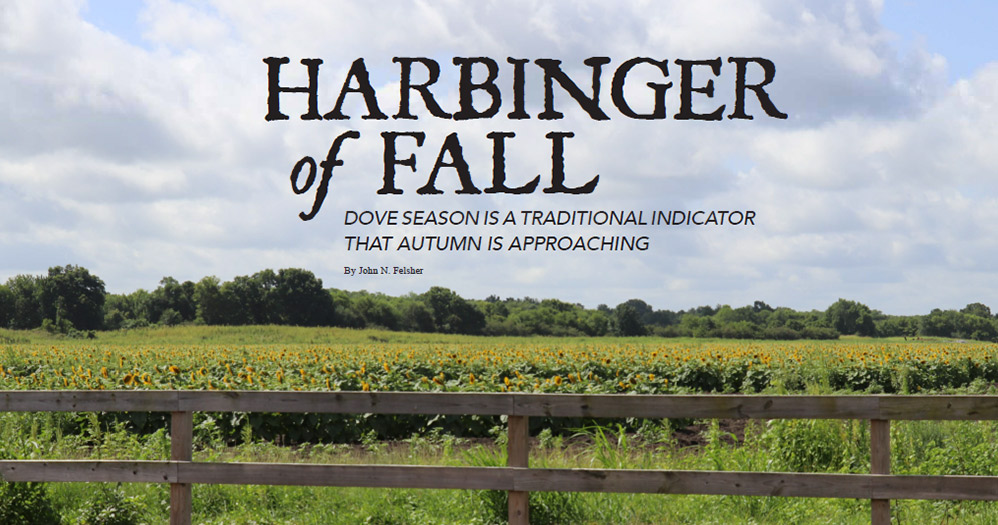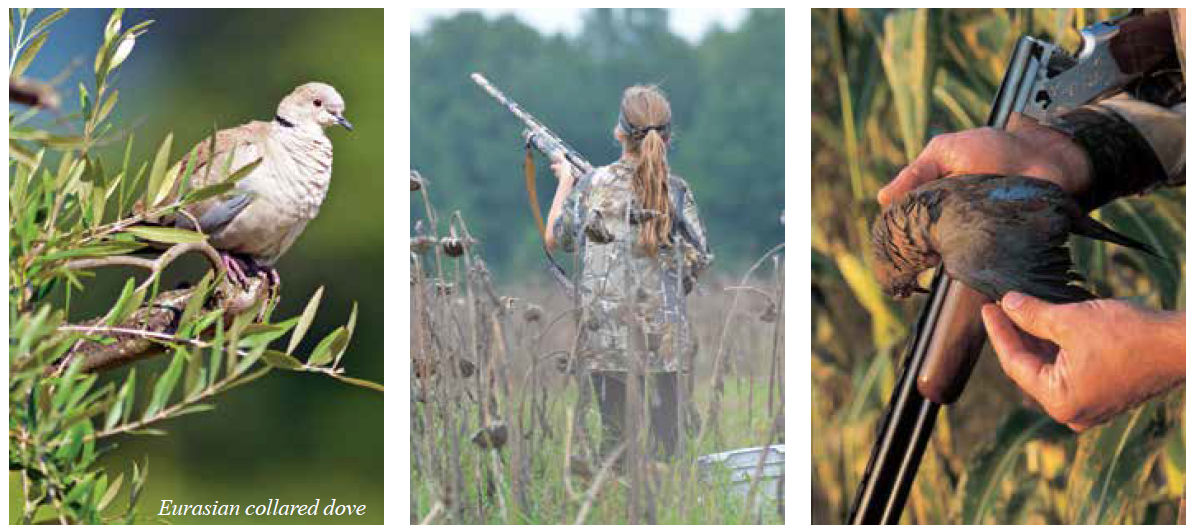Harbinger of Fall
9/20/2018 9:53:42 AM
By John N. Felsher

The beginning of dove season unofficially marks the start of fall and a new season of outdoor adventures for many hunters.
In Mississippi and other Southern states, the September dove opener can become a significant social event. Many farmers manage and harvest their crops to coincide with the opening day so they can invite friends over for a good shoot. Often after sunset, participants gather at the house to enjoy feasting upon freshly grilled dove breasts.
One of the most popular and numerous game birds in North America, mourning doves number in the millions and range from southern Canada to Central America. Approximately 60,000 Mississippi sportsmen bag an estimated million mourning doves annually.
“Due to their migratory behavior, dove populations are monitored on a larger, regional basis,” said Houston Havens, the Mississippi Department of Wildlife, Fisheries, and Parks (MDWFP) Waterfowl Program Coordinator. “In the Eastern Management Unit, which includes Mississippi, population estimates show a slightly declining trend over the last few years. Harvest estimates for the 2017–18 hunting season seem to suggest that the season was perhaps below average over-all. However, as usual, there were certainly still some areas that had excellent dove hunting last season.”
To hunt doves, people first need to find them. The birds can appear in large concentrations one day and disappear the next. Doves typically like open fields, croplands, and brushy pastures with near-by tall trees, fencerows, high wires, or other places that create perching areas where they can watch for predators. Doves do not particularly like thick forests, but hunters can often find them in clearings, food plots, or along woody edges.
“When I go hunting, the first thing I do is scout around looking for birds,” advised Mike Morgan of Florence, who works with Mojo Outdoors. “I watch to see if they are flying in any particular way or flying a particular direction to an area. If they are just going around anywhere, I’ll find an area with my back to the sun. I’ll sit up on a tree line or a fence line with my back to the sun. The sun is one of the best camouflages around.”

Agricultural lands provide excellent food sources for doves. Although they grab an insect occasionally, doves primarily eat small seeds or grains including sunflower, millet, sesame seeds, wheat, corn, and many native grass seeds. Doves can consume their weight in seeds each day. Normally feeding at first light, doves prefer bare, open ground where they can get at the seeds, but with leafy canopies above them to hide them from hawks and other raptors. Sunflowers provide an excellent combination of good food at dirt level plus overhead concealment.
“Quality dove hunting depends on a variety of factors that can change over time, and most regions of the state can experience quality dove hunting at times,” Havens said. “However, in general, areas with a large proportion of harvested agricultural grain crops in early fall tend to be some of the better places for dove hunting.”
After feeding, doves frequently perch in trees or on wires to rest and digest. In mid-afternoon, doves regularly feed again. To break up rough seeds for digestion, doves swallow small pieces of gravel or sand. Sportsmen frequently find doves “dusting” or picking up bits of grit at sandy patches.
The birds must also drink water every day to help them with their digestion. Look for doves around slow streams or ponds marked by sandy or gravel shorelines. With so many people and predators hunting them, thirsty doves do not usually fly directly to the ground. First, they go to a tree or other high object to overlook the area before dropping down to drink. When hunting the right spot, action can come extremely fast. One accurately placed pellet can easily bring a dove down, but the challenge comes in putting that pellet in a vital spot, which is a difficult task. Swift and incredibly agile, doves can embarrass even the most skilled wing shooters with their uncanny knack for seemingly predicting where pellets will go and dodging them in the air at the last second.
Mourning doves can exceed 55 mph, but appear to go much faster because of their twisting, erratic flight patterns. A dove traveling 50 mph will cover about 73 feet in one second. The high-speed shot takes about a tenth of a second to go 40 yards, so one must lead doves accordingly. The challenge of hitting them intensifies the allure of hunting these magnificent, highly prolific game birds.
In addition, hunters should look for bands on every bagged bird to help biologists learn more about doves.
“We are continuing our annual dove banding program this year,” Havens said. “Our goal is to trap and place a metal leg band on about 600 doves each summer. When a hunter harvests a banded bird, the information on the band is reported online. This provides important data to help inform harvest rates and survival estimates, as well as migrations of doves.”
Mississippi hunters targeting mourning doves might also add other species to the game bag. Native to Mexico, Central America, and the southwestern United States, white-winged doves began expanding their range eastward a few years ago. They now occupy parts of Mississippi, particularly along the coast. White-winged doves resemble mourning doves but exhibit bold, white-wing patches that make very distinctive identification marks in flight. Mississippi sportsmen can shoot white-wings during the regular dove season and add them as part of their daily limit.

Eurasian collared doves, another exotic species, arrived in Florida about 30 years ago. Native to Asia, they spread across much of the United States and Mexico since the 1980s. Non-migratory collared doves now inhabit all of Mississippi. Generally much bigger than mourning doves, collared doves grow nearly as large as park pigeons. The distinctive black collars around their necks and squared tails provide the best identifying features on these lighter-colored birds. Collared doves tend to stay around places with human habitation, such as barns, grain silos, parks, and even urban areas.
“Mourning doves make up a large majority of the Mississippi dove harvest,” Havens said. “Based on our hunter survey data, the average bag for dove hunters usually consists of about five mourning doves per hunter per day. White-winged doves are becoming more common in the southern parts of the state along the Gulf Coast. Hunters commonly harvest Eurasian collared doves statewide. In Mississippi, people can shoot collared doves all year long without limit.
During dove season, collared doves do not count in the daily bag limit.” Often many people only hunt doves during opening day or, perhaps, the opening weekend. However, some of the best dove hunting comes later in the year. Although Mississippi holds abundant resident birds, more doves migrate down from states farther north as cold weather hits. Now Mississippi sportsmen can hunt them even later in the winter. “As doves begin to migrate from northern latitudes, late season can be a great time to find large numbers of doves in Mississippi,” Havens said. “A new regulation change for this season, the federal framework will allow us to move the ending date for dove seasons to January 31 in both the North and South Zones. In previous years, the last day allowed for dove seasons was January 15.” Invitations to hunt private fields with good dove populations come at a premium, but several wildlife management areas offer excellent dove hunting opportunities.
Many people hunt the 40-acre sunflower field on Black Prairie WMA near Brooksville. More known for waterfowl, Howard Miller WMA near Rolling Fork, Muscadine Farms WMA near Greenville, and William C. “Billy” Deviney WMA north of Indianola also provide fields where people can hunt doves. Sportsmen can also hunt on some fields owned by the U.S. Army Corps of Engineers. Special regulations on public properties might differ from statewide law, so check what is legal before hunting anywhere.
John N. Felsher is a freelance writer for Mississippi Outdoors.









